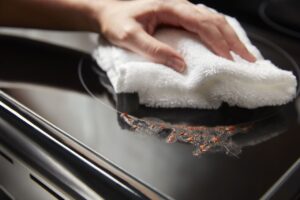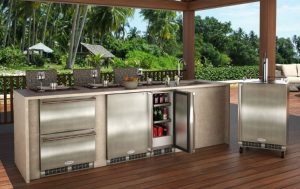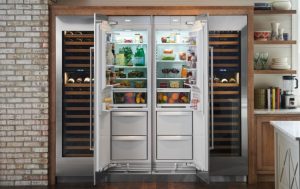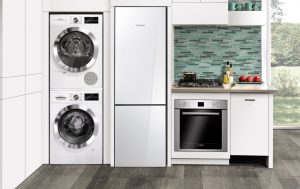Ceramic Cooktops: What are the Pros and Cons?

A cooktop is an important appliance in every kitchen and there are many options to explore. Some choose a gas or electric model, and over the years ceramic cooktops have become popular. They are smooth top appliances that are easy to clean and they have a clean design that matches ultra-modern kitchens. But, like any other appliance they have their unique pros and cons that must be considered carefully.
How Does a Ceramic Cooktop Work?
Before we get into the meat of this article, it’s important to understand how a ceramic cooktop works. The surface is made of tempered glass, it’s smooth to the touch and it’s easy to think that every model is the same, with a few useful features. But there are a few different options to pick from, and each of these works in very different ways:
- Radiant: These cooktops have metal coils that generate heat under the glass surface.
- Halogen: These models generate heat using halogen bulbs.
- Semi-Halogen: This is a combination of the radiant and halogen heating methods shown above.
- Induction: This is a magnet-based system that interacts with metal in pans to generate heat.
The first three ceramic cooktops work in a similar manner, they cook the same and all the usual features and conveniences are present. The only real differences are that halogen bulbs heat up faster and radiant heating elements take longer to cool down.
The fourth option is quite different. An induction cooktop will generate heat much faster and it can boil water twice as fast compared to the other three options. No heat source is required to transfer heat to the pans which improves the efficiency.
An interaction between the metal pans and magnets turns the pan into a self-contained burner. So, the cooktop surface will not generate direct heat and it can’t heat up until a pan is placed on it.
Induction cooktops have a number of useful benefits to consider:
- Improved Efficiency: According to DoE reports an induction cooktop delivers 85% of the energy directly to the cookware which speeds up cooking times and lowers energy bills.
- Hot Air: During induction cooking less hot air is released.
- Responsiveness: Any temperature changes are applied almost immediately to the pans.
Ceramic Cooktop Pros
- Easy Cleaning: Because they have a smooth surface, ceramic cooktops are much easier to clean than electric and gas models. There are no burner caps or grates to remove and clean or places where oil can collect. Any food remnants can be carefully wiped away using a clean cloth and cleaning solution.
- Aesthetic Appeal: A ceramic cooktop will look great in virtually every kitchen unless the homeowner is set on the idea of a truly rustic feel. Because they are a flat and slightly reflective surface these cooktops tend to blend in with their surroundings.
- Safety: Most radiant and halogen-based cooktops have clear heat indicators to warn users that the surface is hot. An induction model will not heat up at all unless a pan is placed in a cooking zone.
- Space: These cooktops are flat surfaces that take up less space in the kitchen than electric or gas cooktop grates. With care it’s even possible to use the surfaces for food prep if space is limited.
Ceramic Cooktop Cons
Nothing is perfect and ceramic cooktops are no exception:
- Burn Risks: The heating element in some ceramic worktops are red when they are active and this color disappears when the cooking zones are inactive. But, the heat remains and it can take some time to cool down fully for cleaning. So, it’s important to take care when you’ve finished cooking to reduce the risk of burning.
- Fragility Issues: Some ceramic cooktops can be more fragile than others and they may need specific cleaning methods. Many manufacturers offer advice on the cleaning tools and solutions that should be used to clean their appliances. It’s important to follow these instructions to avoid scratching the cooktop. Some homeowners may wish to avoid sourcing and buying these cleaning supplies.
- Special Pots and Pans: To use a pan on a ceramic cooktop, it must have a smooth and thick metal bottom. Using copper or aluminum pans can mark the cooktop surface if too much heat is applied and these marks can be hard or impossible to remove. An enamel or painted pan will stick to the surface and it may even crack the tempered glass when removed. So, it’s important to use steel pots and pans that are designed for radiant or induction ceramic cooktops.
- Pricing: A ceramic cooktop tends to cost more than a traditional model and this is especially true with induction appliances. There is also a hidden cost because ferro-magnetic iron cookware that’s compatible with induction cooktops will be required.
FAQs
Can I Use a Ceramic Cooktop as Extra Counter Space?
In theory, yes, but there are some caveats that you need to bear in mind to protect your new ceramic cooktop. Don’t place cans or jars on the surface, they may be heavy (especially if they are full) and if they’re dropped they could crack or break the tempered glass.
Can I Use the Surface as a Cutting Board?
No, it’s all too easy to slip with a knife and scratch your ceramic cooktop. The smooth surface is ill suited to keeping a cutting board stable and this can increase the risk of injury.
Will My Ceramic Cooktop Tolerate Hot Lids?
No, the space under the lid will contain hot air that’s trapped between the lid and the cooktop surface. When the cooktop cools, the tempered glass may break when the lid is picked up.
Can I Use Aluminum Pots and Pans?
No, they may leave marks that in some cases cannot be removed and this may ruin the aesthetic appeal. The rougher finishes on the bottom of copper or aluminum pots and pans increases the risks of scratching too.
How Should I Deal with Sugary Food Spills?
The smooth surface of a ceramic cooktop is pretty easy to clean, but there are a few things to bear in mind if you’ve never used one before. If you spill any foods or liquids that contain sugar, they must be cleaned up quickly to prevent permanent damage to the surface.
To do this safely, wait until the cooktop has cooled slightly and use a scraper to remove the sugary mess. Wear oven mitts to protect your fingers and when the cooktop is fully cooled, clean it as normal with a clean cloth and cleaning solution.
How Do I Choose Appropriate Cookware?
The most efficient way to conduct heat or make the best use of magnet induction technology is to have appropriate flat-bottomed cookware. Cooking with bent, rounded and rounded bottoms will not deliver the necessary heat and it may scratch the cooktop. Before you shop for new cookware, check your existing pots and pans because they may be up to the task. Take a straight edge, lay it on the pan bottom and look for signs of light or space in between. If the surfaces are covered with burnt deposits it may be possible to clean them thoroughly and make them flat again.
If you’re buying an induction cooktop make sure that the cookware you’re keeping or buying will work with this system. Most cookware manufacturers clearly label which items of cookware are suitable for ceramic cooktops and induction cooking.
Can Use Ceramic or Stoneware Cooking Vessels on the Cooktop?
No, these cooking vessels tend to have rougher and less refined bases that are prone to scratching the tempered glass surface. They can also be heavy and there is a risk that they could break the cooktop. To get the best out of your investment, delegate this type of cookware to bakeware where they should be safe to use.
Are There Any Other Items to Avoid?
Yes. don’t place stirring utensils on the cooktop when it’s hot to reduce the risks of scratches or marks that can be very hard or impossible to clean. It may be tempting to place glass bakeware from the oven to the cooktop to cool but this can damage the surface.
Move the bakeware to a dry towel or similar heat conductor on the counter for safe and efficient cooling. Keep materials that are prone to melting, such as: aluminum foil, plastic and others away from the ceramic cooktop surface.
What Do I Use to Clean a Ceramic Cooktop?
Those used to gas cooktops may accidentally use a metal pad on their new ceramic cooktop! These harsh cleaning pads will quickly scratch up the surface and ruin the finish. The better option is a soft cloth or sponge used with a dedicated cleaning solution that’s formulated for these glass surfaces. Gentle rubbing is usually sufficient for cleaning followed by light rinsing with a water soaked sponge. When the surface is fully cooled, it can be dried with a clean and soft towel for a sparkly finish.
Are you looking for a new ceramic cooktop for your kitchen? Check out our online cooktop collection to explore your choices or speak to a home appliance expert for a specialized service.
- Designing the Ultimate Outdoor Bar: Must-Have Appliances for Year-Round Fun
- Luxury Refrigerator Guide 2025: Built-In vs. Freestanding and What to Know Before You Buy
- How Smart Appliances Are Changing Luxury Kitchen Design in 2025
- The Ultimate Outdoor Grill Guide for 2025: Built-In vs. Freestanding
- Smart Bathroom Faucets & Fixtures in 2025: Blending Technology with Luxury Design
- Built-In Coffee Machines: Are They Worth It for Your Kitchen in 2025?
- How to Choose the Right Dishwasher for Your Home: Noise, Capacity, and Features Explained
- Top 5 Kitchen Appliance Colors and Finishes for 2025 (And How to Match Your Style)
- Why a Countertop Ice Maker is a Must-Have for Summer Kitchen Upgrades in Southern California
- How to Remove Scratches from Stainless Steel Luxury Appliances






